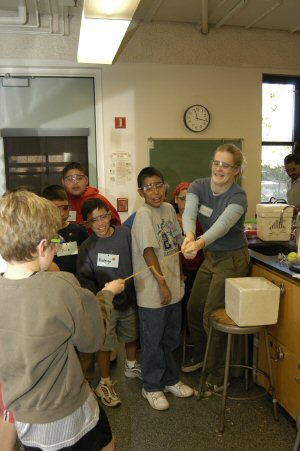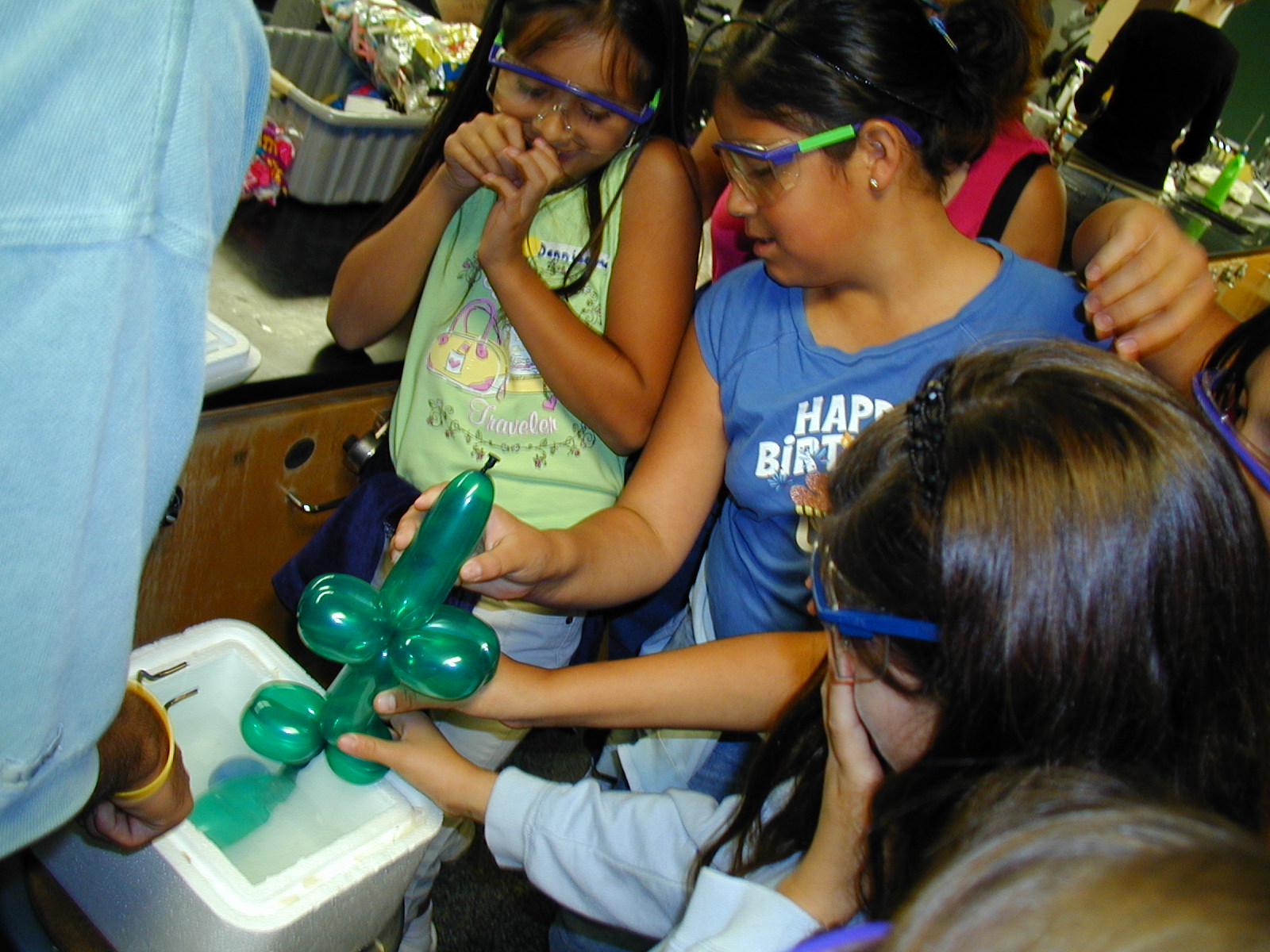1. Freeze Flowers, racquet balls, rubber hose
What happens to flowers when immersed in liquid nitrogen? Have students do this. What do you hear when the flowers are immersed in the liquid nitrogen? What does it sound like? Is the liquid nitrogen boiling?
What about a racquet ball? Show how bouncy the racquet ball is and then put it in the liquid nitrogen. Leave it in liquid nitrogen until the end of their time at this station.
What about a Rubber hose? Show how stretchy it is. Put part of the hose in liquid nitrogen. What are the changes in properties? Have students stretch the frozen hose.

Mention the space shuttle application.
What is liquid nitrogen? How cold is it?
Temperature at which water boils? 100°C
Temperature at which water freezes? 0°C
Temperature of liquid nitrogen? -197°C → very cold!
What is the fog above the liquid nitrogen? Condensed water vapor.
2. Tea Kettle
Put some liquid nitrogen in a tea kettle. Have the students look inside the kettle and see the bubbling liquid. Is the liquid nitrogen boiling? Close the lid and hear the kettle whistle. Donxt we need heat to boil liquid nitrogen? Are we providing heat? Where does the liquid nitrogen get the heat? It absorbs heat from the kettle and from the air around the kettle. Even from water molecules in the air. See the water condensing on the kettle? When we take heat from gaseous water molecules, they condense to form droplets of water
3. Can We Make our Breath into a liquid and a Solid?
Blow up a balloon with air (5-6 inches in diameter, not bigger!) and put it on a test tube.
What is in the air that you blew into the balloon?
N2, O2, CO2, H2O and whatever else is in the air you breathe out.
What is in between the gas molecules in air?
lots of space!
How much space is between the molecules in a gas? Do an experiment to show this.
Immerse the test tube with the balloon on top in liquid nitrogen.
What will happen?
As the gas cools, the molecules slow down. The volume of the balloon decreases and eventually completely deflates.
This takes a little while so do the next activity and come back to this later.
LATER (after you do activity 4):
After the balloon is completely deflated, remove the test tube from the liquid nitrogen.
Ask students what they see inside the test tube?
Look how small the amount of liquid and solid inside the test tube is compared to the original volume of gas in the balloon.
What is inside the test tube? liquid and solid
What liquids? N2(l), O2 (l),
What solids? CO2 (s), H2O (s)
How much space is between the liquid and solid molecules?
Not much - they are in direct contact with each other.
How does the volume of liquid and solid in the test tube compare with the volume of gas in the balloon?
The volume of liquid/solid inside the test tube is much smaller than the volume of gas in the balloon. Thus, there is lots of space between the molecules in the gas.
4. Shrink a Balloon Shaped Like a Dog and Make it Come Back to Life.
Show them a balloon filled with air: How does the balloon stay blown up? Atoms and molecules move, collide with the walls of the balloon, cause pressure inside the balloon.

What happens when we put a balloon filled with air in the hot sun? Why?
Atoms and molecules speed up, increasing the number of collisions with the walls, increasing pressure.
What happens when we put a balloon filled with air in liquid nitrogen? Why? Put balloon in liquid nitrogen. Have students do this also.
Shrinks → molecules slow down
5. Break the racquet ball.
Use tongs to take the very cold racquet ball out of the liquid nitrogen. Hold the racquet ball at about your eye level and drop it. It shatters. Students can each take a piece of the ball to keep. CAUTION: the pieces of the ball are very cold.Show them how to juggle it in their hand to keep it from freezing their hand.
SAFETY: Drop the frozen racquet ball -- throwing it with too much force can cause pieces to fly up and hurt someone.

